Creating A Food Plan: Servings Sizes and Food Exchanges
Please note: This is not to be considered medical advice. I am merely passing on information that I have accumulated over the years. Everyone is unique and has their own personal experience. For any questions or concerns, I recommend consulting your health care provider.
Over the years, nutrition has been an area of interest. I spend a lot of time helping others professionally and personally eat a healthy diet and maintain a proper body weight.
When Yaffa was a baby until age 8, she was failure to thrive and on a feeding tube. We spend a lot of time calculating every calorie, in our effort to help her grow and thrive.
Now that Raizel is a teenager, she is eating better. But, for the longest time, we struggled to achieve healthy growth and development with her too.
My husband is one of the fortunate few for whom maintaining a healthy body weight is not a struggle. But, health maintenance is a priority.
After my pregnancies, it was a struggle to find a food plan that worked for me. Pregnancy was certainly not good for my waistline!
As I was preparing to write this post, I think I inadvertently “bit off more than I could chew,” if you will pardon the pun. I have come to understand just how confusing it is to create an easy and healthy food plan. There is so much conflicting and confusing information!
The original exchange plan, developed for diabetics, and used by many weight loss programs is the easiest and healthiest food plan method to use. It is based on individual food categories, which include Grain/Starch, Protein, Fruit, Vegetables, Milk, Fat and Other Carbohydrates (includes sweets and alcohol). Within each category, one may substitute or exchange one portion of food for another.
Using this method, one can create an individualized food plan to accommodate one’s specific needs and lifestyle. Menu planning is flexible, easy and still nutritious.
Simple is best!
Principles For Healthy Eating
I have integrated the concept of food exchanges with my own personal views of health and well-being.
As I listed above in my picture, I believe that healthy eating includes:
・Balancing intake in all food groups
・Little or no refined sugars or flours
・Using whole grains
・No artificial flavors, sweeteners,
・No dyes, additives or preservatives
・No hydrogenated oils/fats
・Limiting animal protein to <6 oz./day
In my experience, white flour and sugar affect the mood and feelings of well-being in people who are sensitive. I call this being “carbohydrate sensitive.” For “carbohydrate sensitive” people, refined flour, sugar and even fruit can trigger mood swings. Therefore, in my food exchange lists, I have calculated serving sizes based on whether or not someone is carbohydrate sensitive or not. For ease, I suggest sticking to either one or the other and to be consistent.
I am a slightly carbohydrate sensitive person. I personally avoid refined sugar and flour. For this reason, I also prefer to eat vegetables over fruit. I believe that this has made a world of difference for me. I attribute part of my ability to cope with the stress of having special needs children to my diet.
Other people find it difficult to digest fat. For this reason, I believe in eating healthy, preferably unsaturated fats. We do not eat products with partially-hydrogenated fats/oils.
My daughter used to be on the Feingold Diet. From this, we learned to eliminate dyes, additives, preservatives and artificial flavors including artificial sweeteners from our diet. In people who are sensitive, artificial flavors, dyes and preservative function as what I call “neurotoxins.” I loved the Feingold Diet. I found that it did wonders for my daughter!
Finally, I believe in limiting animal protein– eggs, fish, poultry and meat to no more than 6 oz. per day. Other protein sources should be plant-based or dairy.
Personally, I am allergic to dairy, and I use milk from other sources.
I think that I want a little over board, but, I made the pictures to help clarify what the choices are within each food category.
Dairy
• 1-3 servings/day (optional)
• Are you carb sensitive?
• If yes, then 1 serving is:
– 8 oz milk
– 6 oz yogurt
If NOT carb sensitive, 1 serving is:
– 8 oz milk/ 6 oz. yogurt
– 4 oz. cottage cheese,
– 2 oz. hard cheese.
Protein
• 6-13 or more servings /day
• Limit animal protein to 3-6 oz./day
• Are you carb sensitive?
• IF NOT THEN: 1 oz. fish, chicken , cottage cheese, meat, 1 egg, 1.5 oz. tofu/cooked beans, ½ oz. nuts, ½ oz. hard cheese
• IF YES THEN 1 serving is 1 oz. chicken, fish or meat, 1 egg, 2 oz. cottage cheese or ricotta cheese, ¼ cup or 2 oz. cooked beans, 1 oz. regular tofu or 2 oz. soft/silken tofu, 1 Tbs. peanut butter, 1 oz. nuts & hard cheese = 2 oz. protein
• Super Carb Sensitive? Count legumes as a carbohydrate
• In this diet, red meat is eaten no more than 1/week; chicken, fish & eggs are eaten 2-3 times per week. Therefore,1-2 meals /day must be vegan or plant-based.
Grains
• 1-8 servings/day
• 1 serving is 1 oz. raw cereal or grain
• Are you carb sensitive?
• Not carb sensitive then 1 serving is 1 slice bread, ½ cooked pasta, potatoes, rice, 1 oz. dry cereal, 4 oz. cooked potatoes, yams; 3 oz. cooked grains
• Carb sensitive: ½ cup cooked corn, peas, winter squash and other starchy vegetables
• Super carb sensitive? ½ cup (4 oz.) beans as a starch, rather than a protein.
• Recommend whole grains and limited refined flours. And recommend whole grain cereal, bread and pasta.
Vegetables
• 4-8 servings/day
• 1 serving is: 1 cup (4 oz. weighed) raw vegetables or ½ cup (3 oz. weighed) cook vegetables.
• Are you carb sensitive?
• IF NOT then include starchy vegetables, i.e., corn, peas, and winter squash as vegetable servings.
• If yes, then consume only low-starch vegetables as vegetable servings.
• If carb sensitive, then count peas, corn and winter squash as a starch/grain serving.
• Eat a variety of colors and types; include dark, leafy green vegetables daily.
Fruit
• 1-5 Servings/day
• 1 serving is 6 oz. (1 cup) of cut-up fresh fruit.
• ¾ cups or 6 oz. frozen, unsweetened fruit (after thawing)
• 2 oz. dried fruit (use sparingly)
• 1 moderate piece of fruit
• ½ cup canned fruit packed in its own juices
• Are you carb sensitive? Avoid cherries, grapes, pineapple, bananas & dried fruit
• Can substitute 1 fruit for 2 vegetable servings.
• Eat a variety of colors and types.
Fat
• 2 – 3 servings/day
• 1 serving is 1 Tablespoon or .5 oz and equals 15-21 grams of fat
• Other sources of fat: 2 oz. avocado, 2 Tbs. cream cheese, 2 Tbs. shredded coconut, 1 Tbs. mayonnaise
• Use unsaturated fat or oil. Avoid saturated fats like margarine and butter.
Other food groups
Alcohol (optional)
• 1 serving/day for women
• 2 servings/day for men
This is optional and considered a grain or sugar.
Sugar (optional)
• 0-5 servings per week
• 1 Tbs. sugar, jelly, jam, ½ cup sorbet and ices, 1 cup lemonade
• Use sparingly
Putting It All Together: I have more data and information on daily food requirements and creating your own food plan, but, I believe in not overwhelming people with too much information. So, I will post more on this later.
Thank you all for reading this! I know that it was a lot of information.
References: There are more, but this is a beginning
Food_Choices_and_Serving_Sizes_AMD
Please note: This is not to be considered medical advice. I am merely passing on information that I have accumulated over the years. Everyone is unique and has their own personal experience. For any questions or concerns, I recommend consulting your health care provider.

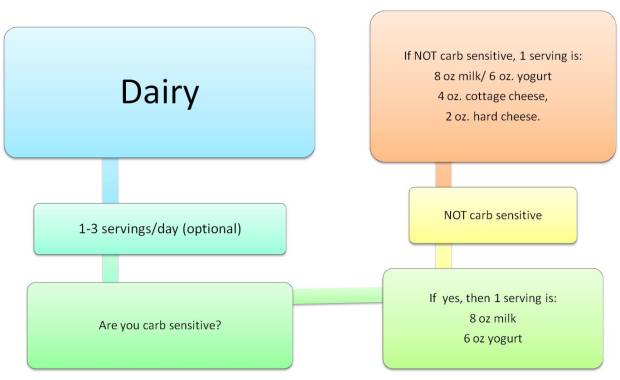
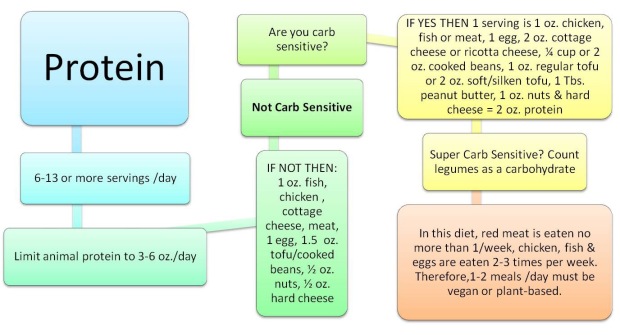
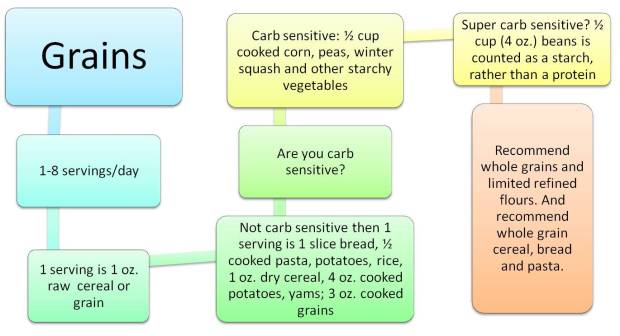
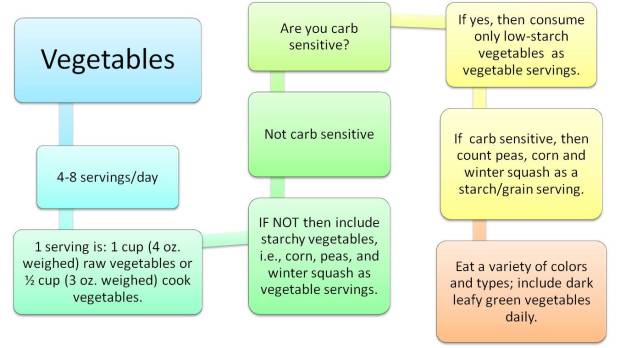

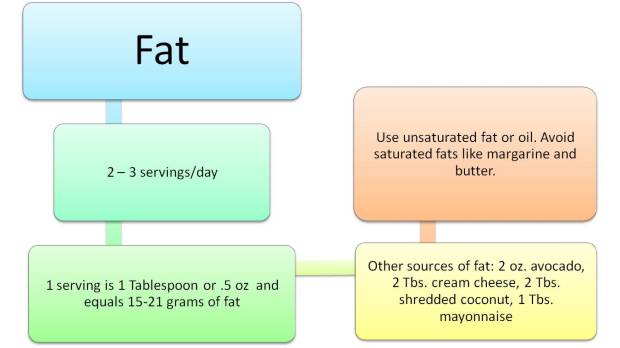
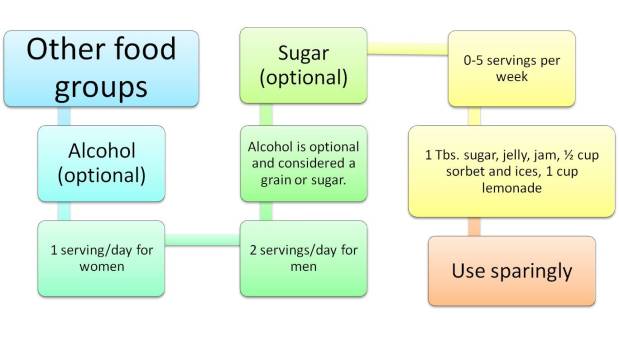
You put a lot of work into this post. The charts simplify things for most people. I hope these charts provide the missing pieces people need to improve the eating lifestyle. Thank you so much for sharing this valuable information.
LikeLiked by 2 people
Thank you! I hope it helps too. As you have written, a proper diet is the first step towards optimum health.
LikeLike
This is wonderful information to share! The less processed food we eat the better. I like to think of Michael Pollan’s advice… don’t eat anything your great-grandmother wouldn’t recognize; don’t buy anything with more than 5 ingredients; mostly shop the perimeter of the grocery store; cook, when and if you can. The last is easy for me because I love to cook, but so many people don’t because they don’t know how or feel pressed for time. I’d love to see schools bringing home ec back, so people can learn to shop, budget, and get in the kitchen! Again, thank you for the time and effort you put into pulling this together. Great message!
LikeLiked by 2 people
Thank you! I love your comment. It’s true: really it’s like eating a 1950’s diet, before so many chemicals were added to food.
LikeLiked by 1 person
Very nice post Carol! Thanks so much for giving us this important information! Something many struggle with! xx
LikeLiked by 1 person
Thank you for reading. I thought it would be simple, but I feel like I am writing a book 📚
LikeLiked by 1 person
Yes you put so much work into it! Very nice!
LikeLiked by 1 person
Thank you for your support. This is an important subject, because many people have real difficulties in this area, for all kinds of complicated reasons.
LikeLike
Thanks Carol for posting such a informative post.👍
LikeLiked by 1 person
Thank you for taking the time to read it. It was a lot of information!
LikeLiked by 1 person
This is a well-thought-out informative post, thank you! The charts are a great addition too. I’m a visual person.
LikeLiked by 1 person
Thank you!
LikeLiked by 1 person
I wanted to say that I am so happy they were helpful! I was very concerned that it would be confusing and not helpful, which would defeat the whole purpose of doing it.
LikeLiked by 1 person
Thank you for this very useful, and informative post 🙂 . I always find these posts so helpful.
LikeLiked by 2 people
I am so happy! I felt like I might have gone overboard with all this information. Plus, there is sooooooo much information available that it is easy to get confused.
LikeLike
Very good advices, as you found are working good for your family. I have had problems with allergies for both my kids and myself and learned how to make everything from scratch many years ago. I try my best to continue that way. I can’t stand soya, which make it difficult, when I wish to avoid other kind of food.
LikeLiked by 2 people
I try to limit my soy too.
LikeLiked by 1 person
Mostly farm animals are eating a lot of soya and not all are away, when we are eating them, even many health experts say so. Otherwise I would not be so sick by the food.
LikeLiked by 1 person
True! We are what we eat.
LikeLiked by 1 person
Very nicely done. My household has shrunk to just hubby and me most of the time so there are no food sensitivities. But portion control and healthy eating are still our goals.
LikeLiked by 2 people
Yes. I was going to do something on portion control except that I feel like I am reinventing the wheel!
LikeLike
Another excellent reference (and further references) to explore. Thank you so much for putting this together … it is a minefield for most of us and having it set down simply is hugely helpful. I am carbohydrate sensitive (I like this label) as are my daughters. I have sent a link to each of them as they too will find this helpful. Namaste 🙂
LikeLiked by 2 people
I hope it helps. It is my term for people who have varying degrees of sensitivity to food, (usually sugar and starch) and mood. It really makes a difference! I feel like it changed my life. It is not the whole picture, of course, but a very useful tool.
LikeLiked by 1 person